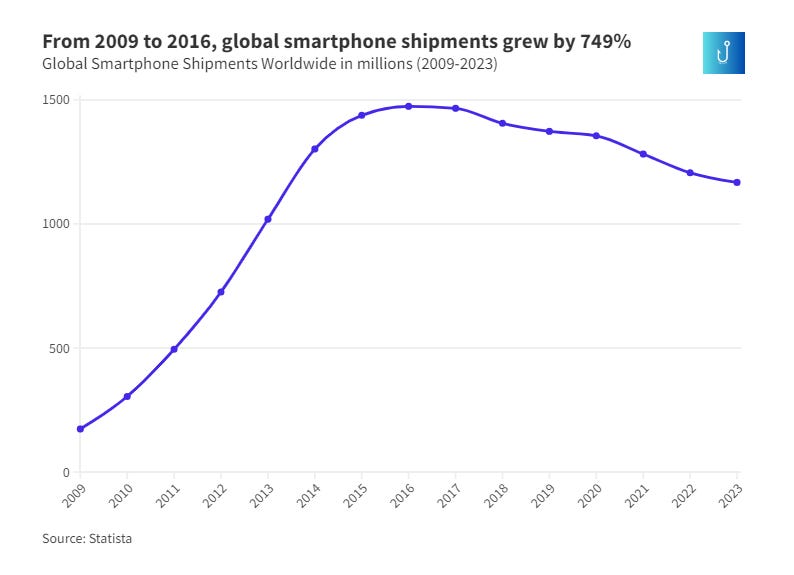Smartphones Rise, TVs Decline: The Shift in Our Screens
Thank you for reading The Hook! This free weekly newsletter explores the data behind specific fields of human endeavour: sports, pop culture, economy, digital economy, and entertainment. It lands in the inbox of over 50 subscribers every week! You can support this newsletter by sharing this free post.
Hello Everyone. TGIF.
How’s the week been for you?
My week has been super productive and I can’t wait to rest this weekend.
If you missed last week’s newsletter, you can read it here.
Here’s a quick fun fact before you read today’s newsletter
2.5 million dollars
The price of Stuart Hughes Prestige HD Supreme Rose Edition (The most expensive TV in the world).
Now to this week’s newsletter:
Global smartphone shipments are booming while TV shipments decline—an undeniable shift in how we consume content. With over 1 billion units shipped annually, smartphones have revolutionised our relationship with screens. The decline of TV shipments, down by 4.9% in Q1 2024 alone, speaks volumes. Why wait for your show when mobile computing gives you everything—streaming, gaming, and browsing—at your fingertips?
It wasn’t always this way. TVs once defined home entertainment. People huddled around the television to catch a glimpse of the news, TV shows, and major sporting events. All that changed with the arrival of the smartphone. Much of this increase can be attributed to the iPhone release in 2007. With its consumer-friendly design, Apple introduced multimedia functions to smartphones, offering more than basic features such as email and web browsing. This pushed the competitors to respond with new models and began to shape consumers’ habits. Android devices followed suit and continue to push the boundaries of innovation.
This shift can be observed in smartphone vendors’ shipment figures. The global smartphone market saw exceptional growth from 2009, when 173 million smartphones were shipped worldwide to 2016 when smartphone shipments amounted to 1.47 billion.
What's fueling this shift? Accessibility and convenience. Phones offer instant access to streaming services, social media, and even work; blending productivity and leisure seamlessly. The era of huddling around a TV has been replaced by individual screen time, where everyone can watch what they want, when they want, wherever they are.
Data from Oberlo reveals that 59.7% of all web traffic came through mobile phones as of July 2024- further proving that we're glued to our smartphones more than ever. With apps designed for on-the-go lifestyles, why bother sitting down in front of a traditional TV? Streaming giants like Netflix and YouTube report that more than half of their viewing hours come from mobile devices, signalling an irreversible trend.
Television shipments continue to suffer a decline as seen in the chart below.
So, what's next for TV manufacturers? Some are pivoting to smart TVs or integrating them with voice assistants, but the challenge remains: in a mobile-first world, can they keep up?
Meanwhile, smartphone makers are pushing boundaries with foldable screens, high-refresh displays, and 5G connectivity, ensuring that mobile computing remains king.
The bottom line? As smartphones rise, traditional TV screens are getting left in the dust. Mobile is the future, and the future is already here.
Now to a fun activity
Do you have a television at home?
If you do, how many times a week do you watch it?
If you have any feedback or suggestions on how to improve the newsletter, please share them with me.





